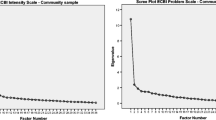Abstract
The cross-cultural validity of the Child Behavior Checklist for Ages 2-3 (CBCL/2-3) was tested in three Dutch samples of children referred to mental health services, from the general population, and from a twin study. Six scales were derived from factor analyses and labeled Oppositional, Aggressive, and Overactive, which constituted a broadband Externalizing grouping; Withdrawn/Depressed and Anxious, which constituted a broadband Internalizing grouping; and Sleep Problems. Internal consistencies of the scales, their test-retest reliabilities, interparent agreement, discriminative power, predictive relations with problem ratings 2 years later, and relations to other instruments designed to measure general development and behavior problems were adequate, and highly comparable to psychometric properties in American samples. It was concluded that across languages and cultures behavioral/emotional problems of young preschoolers may be adequately assessed with the CBCL/2-3.
Similar content being viewed by others
REFERENCES
Achenbach, T. M. (1991). Manual for the Child Behavior Checklist/4–18 and 1991 profile. Burlington: University of Vermont, Department of Psychiatry.
Achenbach, T. M. (1992). Manual for the Child Behavior Checklist/2–3 and 1992 profile. Burlington: University of Vermont, Department of Psychiatry.
Achenbach, T. M. (1993). Empirically based taxonomy: How to use syndromes and profile types derived from the CBCL, TRF, and YSR. Burlington: University of Vermont, Department of Psychiatry.
Achenbach, T. M., Edelbrock, C., & Howell, C. T. (1987). Empirically based assessment of the behavioral/emotional problems of 2-and 3-year-old children. Journal of Abnormal Child Psychology, 15, 629–650.
Achenbach, T. M., McConaughy, S. H., & Howell, C. T. (1987). Child/adolescent behavioral and emotional problems: Implications of cross-informant correlations for situational specificity. Psychological Bulletin, 101, 213–232.
Achenbach, T. M., Verhulst, F. C., Baron, G. D., & Althaus, M. (1987). A comparison of syndromes derived from the Child Behavior Checklist for American and Dutch boys aged 6–11 and 12–16. Journal of Child Psychology and Psychiatry, 28, 437–453.
American Psychiatric Association. (1994). Diagnostic and statistical manual of mental disorders (4th ed.), Washington, DC: Author.
Behar, L. B., & Stringfield, S. (1974). A behavior rating scale for the preschool child. Developmental Psychology, 10, 601–610.
Campbell, S. B. (1990). Behavior problems in preschool children: Clinical and developmental issues. New York: Guilford Press.
Campbell, S. B. (1995). Behavior problems in preschool children: A review of recent research. Journal of Child Psychology and Psychiatry, 36, 113–149.
Campbell, D. T., & Fiske, D. W. (1959). Convergent and discriminant validation by the multitrait-multimethod matrix. Psychological Bulletin, 56, 81–105.
Central Bureau of Statistics (CBS). (1987). Standard educational classification 1978; Edition 1987. Voorburg: CBS.
Cohen, J. (1988). Statistical power analysis for the behavioral sciences (2nd ed.). New York: Academic Press.
de Groot, A., Koot, H. M., & Verhulst, F. C. (1994). Cross-cultural generalizability of the Child Behavior Checklist Cross-informant syndromes. Psychological Assessment, 6, 225–230.
Fleiss, J. L. (1981). Statistical methods for rates and proportions (2nd ed.). New York: Wiley.
Ireton, H., & Thwing, E. J. (1974). Minnesota Child Development Inventory. Minneapolis: Behavior Science Systems.
Jöreskog, K. G., & Sörbom, D. (1989). LISREL 7: A guide to the program and applications. Chicago: SPSS.
Koot, H. M., & Verhulst, F. C. (1991). Prevalence of problem behavior in Dutch children aged 2–3. Acta Psychiatrics Scandinavica, 83 (Suppl. 367), 1–37.
Richman, N. (1977). Is a behaviour checklist for preschool children useful? In P. J. Graham (Ed.), Epidemiological approaches to child psychiatry (pp. 125–137). London: Academic Press.
Richman, N., & Graham, P. J. (1971). A behavioural screening questionnaire for use with three-year-old children: Preliminary findings. Journal of Child Psychology and Psychiatry, 12, 5–33.
Richman, N., & Lansdown, R. (Eds.). (1988). Problems of pre-school children. Chichester: Wiley.
Richman, N., Stevenson, J., & Graham, P. J. (1982). Pre-school to school A behavioural study. London: Academic Press.
Rutter, M., Tuma, A. H., & Lann, I. S. (Eds.). (1988). Assessment and diagnosis in child psychopathology. New York: Guilford Press.
SAS Institute (1989). SAS user's guide, Release 6.07.02. Gary, NC: Author.
Snook, S. C., & Gorsuch, R. L. (1989). Component analysis versus common factor analysis: A Monte Carlo study. Psychological Bulletin, 106, 148–154.
Spiker, D., Kraemer, H. C., Constantine, N. A., and Bryant, D. (1992). Reliability and validity of behavior problem checklists as measures of stable traits in low birth weight, premature preschoolers. Child Development, 63, 1481–1496.
Tanaka, J. S., & Huba, G. J. (1984). Hierarchical confirmatory factor analyses of psychological distress measures. Journal of Personality and Social Psychology, 46, 621–635.
Trad, P. V. (1989). The preschool child. New York: Wiley.
Van Westerlaak, J. M., Kropman, J. A., & Collaris, J. W. M. (1975). Beroepenklapper [Index of occupations]. Nijmegen, The Netherlands: Instuut voor Toegepaste Sociologie.
Verhulst, F. C. (1995). A review of community studies. In F. C. Verhust & H. M. Koot (Eds.), The epidemiology of child and adolescent psychopathology (pp. 146–177). Oxford, England: Oxford University Press.
Verhulst, F. C., Achenbach, T. M., Althaus, M., & Akkerhuis, G. W. (1988). A comparison of syndromes derived from the Child Behavior Checklist for American and Dutch girls aged 6–11 and 12–16. Journal of Child Psychology and Psychiatry, 29, 879–895.
Verhulst, F. C., Akkerhuis, G. W., & Althaus, M. (1985). Mental health in dutch children: I. A cross-cultural comparison. Acta Psychiatrica Scandinavica, 72 (Suppl. No. 323, pp. 1–108).
Wenar, C. (1994). Developmental psychopathology: From infancy through adolescence. New York: McGraw-Hill.
Author information
Authors and Affiliations
Rights and permissions
About this article
Cite this article
Koot, H.M., Van Den Oord, E.J.C.G., Verhulst, F.C. et al. Behavioral and Emotional Problems in Young Preschoolers: Cross-Cultural Testing of the Validity of the Child Behavior Checklist/2-3. J Abnorm Child Psychol 25, 183–196 (1997). https://doi.org/10.1023/A:1025791814893
Issue Date:
DOI: https://doi.org/10.1023/A:1025791814893




